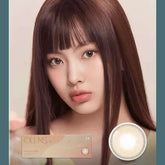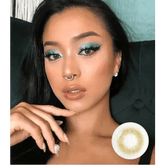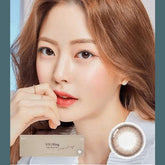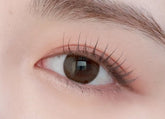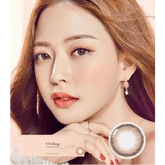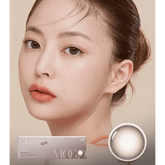Welcome to your complete guide to K-Pop color lenses. We’ve organized common questions into clear categories so you can find answers fast—use the topic filter above to jump straight to what you need. From getting started and choosing styles to care tips and troubleshooting, this page covers the essentials to shop with confidence.
Filter by Topic
All
- All
- I. Getting Started
- II. Find Your Idol Look
- III. Lens Care & Makeup
- IV. Troubleshooting
Need Help?
Can’t find the answer you’re looking for? Send us a message via our contact form and we’ll assist you as quickly as possible. For order inquiries, please include your order number; for delivery issues, add brief details and photos of the parcel/label/items to speed things up.
I. Getting Started
Q. I don't know my prescription. Can I just buy lenses with the same prescription as my old glasses?
A. Absolutely not. This is one of the most common and dangerous mistakes beginners make. Eyeglasses and contact lenses are prescribed with different powers due to the distance difference from the eye. An eyeglass lens sits about 12mm away from your eye, while a contact lens is placed directly on the cornea. Because of this distance, the required correction value changes, especially for higher prescriptions.
If you buy contact lenses with your glasses prescription, you might experience dizziness or find that your vision isn't properly corrected. You must visit an optician to get a separate eye exam specifically for contact lenses to determine the correct prescription. This is an essential step not only for clear vision but also for reducing eye strain and ensuring safe lens wear.
Q. I have astigmatism. Do I have to give up on color lenses? What's different about toric color lenses?
A. Having astigmatism doesn't mean you have to miss out on color lenses. There are many "toric" color lenses available on the market specifically for astigmatism. Astigmatism occurs when the cornea is shaped more like a football than a perfect sphere, causing light to focus on multiple points instead of one. This can make objects appear blurry or doubled when wearing standard lenses.
Toric lenses are designed to correct this irregular refraction. They have an additional Axis and Cylinder value and feature a special design (axis stabilization design) to prevent the lens from rotating in the eye, ensuring it stays in the correct orientation. However, the variety of options may be more limited than regular lenses, and they often require custom ordering, which can make the purchasing process a bit more complex. Some users also report that the vision correction with toric color lenses feels like it's at about 70-80% of the clarity of clear toric lenses. Brands like Acuvue, OLENS, and Interojo (Clalen) offer toric color lenses , so it's important to consult with a professional to find the right product for you.
Q. What do DIA, G.DIA, and BC on the lens box mean, and which one is important for me?
A. These three numbers are like the "ID card" for your lenses. Understanding them is crucial for choosing a pair that fits perfectly.
BC (Base Curve): This indicates how curved the lens is. Everyone's cornea has a unique curve, so you need to wear a lens with a BC that matches yours. If the BC is too large (flatter), the lens will be loose and cause the 'hula effect.' If it's too small (steeper), it will squeeze your eye, causing redness and pain. This value must be determined by a professional and is the most critical number for comfort and safety.
DIA (Diameter): This is the total diameter of the lens. Most products range from 14.0mm to 14.5mm. This can affect the initial feeling of comfort or foreign body sensation when you first put the lens in.
G.DIA (Graphic Diameter): This refers to the diameter of the colored or graphic part of the lens, excluding the transparent outer edge. This is the number that determines how large your pupils will look. From a styling perspective, this is the most important number to consider when you want to achieve that K-pop idol look.
Q. Why is buying color lenses online illegal in South Korea? Is it okay to buy them from overseas websites?
A. The reason online sales of contact lenses are banned in South Korea is that the government has determined that protecting public eye health is a greater public interest than consumer convenience. The Constitutional Court of Korea has upheld the law that enforces this.
Allowing online sales would increase the likelihood of people buying and wearing lenses without a professional eye exam. This could lead to wearing lenses that don't match an individual's BC or eye condition, causing serious side effects. It also makes it difficult to manage quality control during distribution and to assign liability. In-person sales by an optician act as a minimum safety measure to reduce these risks. Buying from overseas websites is equally dangerous for the same reasons. The products may not have been officially safety-tested, and there's no way to confirm if they fit your eyes, which could lead to severe eye diseases. It is strongly advised to avoid this.
Q. Lenses from famous brands (OLENS, LENSME) are expensive. Why are the cheap ones sold online or in accessory shops dangerous?
A. The price difference isn't just for the brand name. It reflects the cost of safe materials, precise manufacturing processes, and investment in research and development. All color lenses officially distributed in Korea are classified as 'medical devices' and must be approved by the Ministry of Food and Drug Safety.
In contrast, cheap lenses sold through non-professional channels like the internet or accessory shops are highly unlikely to meet these safety standards. These products carry serious risks:
Harmful Dyes: They may use industrial-grade dyes that are not approved for medical use. If these dyes come into direct contact with the eye, they can cause inflammation or allergic reactions.
Rough Surface: The color might be simply coated onto the lens surface, making it rough and uneven. This can cause micro-scratches on your cornea, creating a pathway for bacterial infections.
Low Oxygen Permeability: The lens material itself may be of low quality, or the dye layer can block the flow of oxygen to your cornea. This is a primary cause of serious complications like redness, corneal edema, and even corneal neovascularization (the growth of new blood vessels into the cornea).
Trying to save a few dollars could cost you your lifelong eye health. Always purchase officially approved products through a professional.
Q. Can I try on test lenses at the optical shop? What should I check for when trying them?
A. Most optical shops provide trial lenses for products you're considering. If it's your first time, you should definitely request a trial to see if they fit you well. Just wearing them for a few minutes isn't enough. You should try to wear them for at least a few hours during your daily routine and carefully check the following:
Initial Comfort: Is there any significant foreign body sensation or discomfort when you first put them in?
Vision Stability: Does your vision stay clear and stable when you blink or move your eyes?
Lens Movement: Look in the mirror and move your eyes left, right, up, and down. Does the lens stay centered on your pupil, or does it move excessively (hula effect) or drift to one side?
Color Payoff: How does the lens color look under indoor lighting versus natural daylight? It might look different than you expected.
Dryness: Pay attention to how dry or gritty your eyes feel as time passes.
By communicating any issues you notice during the trial to your optician, you can get better recommendations for a lens that truly suits you.
Q. What are the most popular color lens brands and best-selling products in Korea?
A. The Korean color lens market is dominated by 'OLENS,' which holds an overwhelming market share of about 50%. Following behind are brands like LENS ME, Davich Optical's lens brand, Acuvue, and Interojo (Clalen).
The secret to OLENS's success lies in its trend-setting designs and extensive product lineup. Among them, a few products have become "steady sellers," beloved for years.
OLENS 'ViVi Ring': Nicknamed the 'Nation's First Love Lens,' this product creates a pure and lovely look with its soft colors and subtle limbal ring. The Brown and Choco colors are considered the gold standard for daily lenses.
OLENS 'Spanish': This is the original 'iris lens' that changes only the iris color without a dark outer circle. With a small graphic diameter of 11.9mm, it offers an exotic yet natural look, maintaining its popularity.
Besides these, every brand releases new products with fresh designs and materials each season, creating a competitive market. Exploring the latest trends and trying various products is part of the fun of finding your own "holy grail" lens.
II. Find Your Idol Look
Q. Is a bigger 'Graphic Diameter (G.DIA)' always better? How do I find the right G.DIA for my eyes?
A. The idea that 'bigger is always better' is a common misconception. Choosing a lens with an excessively large graphic diameter without considering your own eye size or iris ratio can result in an unnatural, "bug-eyed" look where very little of the white of your eye is visible. The key is to find the most natural and beautiful proportion.
Generally, the average Korean iris diameter is between 11-12mm. A simple tip for finding the golden ratio is to choose a graphic diameter that is about 1-1.5mm larger than your own iris. Here is a more specific guide :
Natural 'Kku-an-kku' Look (12.8mm ~ 13.4mm): The ideal size when you want to subtly enhance your natural eye color and mood, as if it were your own eyes.
Clear & Defined Eyes (13.6mm ~ 14.0mm): Suitable when you want a noticeable enlarging effect. It looks even more attractive when paired with makeup.
Glamorous & Unique Style (>14.0mm): Can be chosen for special occasions or when you want to make a bold statement, but may be a bit overwhelming for daily wear.
Start by assessing your own iris size in the mirror and choose the appropriate G.DIA based on your desired style. This is the shortcut to a successful lens purchase.
Q. I got my 'Personal Color' analysis done. How do I choose lenses for my warm/cool tone?
A. Your personal color is the best guide to reducing the chances of a lens fail. Wearing lenses that match your skin tone can have a brightening effect on your entire face, as if you've turned on a spotlight.
Warm Tones (Spring/Autumn): If your skin has yellow or peachy undertones, warm and soft colors will suit you best. Look for lenses with hints of gold, yellow, or olive. Fail-safe choices include choco, caramel brown, amber brown, hazel, khaki, and olive green.
Cool Tones (Summer/Winter): If your skin has pink or blue undertones, cool and crisp colors are your best bet. Choosing lenses with hints of blue, pink, or ash will make your skin look clearer and more translucent. Recommended colors include ash gray, cool gray, blue, lavender, rose brown, and bluish-black.
Of course, this is a basic guide. A gray lens with a brown pattern mixed in can also look great on warm tones. The subtle differences in tone are important, so it's a good idea to check out various user reviews.
Q. I'm an 'Autumn Mute' tone, so bright colors don't suit me. Can you recommend some soft, muted-tone lenses?
A. Considering the sub-tones of your personal color allows for even more refined styling. 'Mute' tones (Autumn Mute, Summer Mute) are best suited to soft colors with low saturation and a hint of gray. Therefore, the key is to avoid highly saturated, vivid colors and strong contrasts when choosing lenses.
For Autumn Mute tones, I recommend soft, low-saturation colors like ash brown, dusty olive, soft khaki, and mute gray. The graphic design is also important. Instead of designs with a sharp, dark limbal ring, choose graphics with a blurry, gradient-style edge that blends naturally. The goal for mute-tone styling is to maximize a soft and deep atmosphere with your lenses.
Q. I just dyed my hair. How can I match my lens color to my hair color for a natural look?
A. A 'tone-on-tone' match between your hair and lens color is a key technique to elevate your overall look. The basic principle is to match the hue, brightness, and undertone of your hair.
Ash/Cool-Toned Hair (Ash Brown, Ash Gray, Blue Black, etc.): Match the cool feel of your hair by choosing cool-toned lenses like ash gray, blue-gray, or cool brown. This creates a chic and urban image.
Warm Brown/Red-Toned Hair (Choco Brown, Orange Brown, Red Wine, etc.): Wear lenses in colors like choco, amber, hazel, or olive green to harmonize with your warm hair color for a soft and vibrant impression.
Black/Dark Brown Hair: Dark hair can create various moods depending on the lens choice. Deep brown or choco lenses give a natural and neat look, while cool gray or blue lenses create a strong contrast for a mysterious and chic appeal.
Q. I have small eyes, and large diameter lenses give me an unnatural "bug-eyed" look. Are there any lenses that make my eyes look naturally defined?
A. The biggest concern for people with smaller eyes is the "bug-eyed" effect. This happens when the graphic diameter (G.DIA) is too large for your iris proportion, leaving very little of the white part of your eye visible. The solution is twofold: a small graphic diameter and a natural graphic design.
First, it's essential to choose 'small-diameter lenses' with a G.DIA of 13.0mm or less. More importantly, pay attention to the graphic design. Avoid lenses with a distinct, dark 'limbal ring' that artificially outlines the iris. Instead, opt for lenses with a blurry, faded edge or 'iris lenses' that change only the iris color without any limbal ring at all. Products like OLENS' 'Spanish' or 'Scandi' lines, with graphic diameters as small as 11.9mm, change only the color while maintaining your natural pupil size, creating the most natural transformation.
Q. What are the trendy 'Kku-an-kku' style lenses everyone is talking about?
A. 'Kku-an-kku' (effortlessly chic, or the "no-makeup makeup" look) is a major trend in the K-beauty world, and the color lens market is no exception. The essence of a 'Kku-an-kku' lens is its naturalness, making people wonder, "Were my eyes always this beautiful?"
These lenses share a few key features.
First, a small graphic diameter (G.DIA), typically between 11.9mm and 13.2mm, which doesn't excessively enlarge the eyes.
Second, delicate and soft graphics. Instead of a harsh limbal ring, they feature a subtle gradient or fine pattern that blends seamlessly with the natural iris.
Third, natural colors. They usually come in neutral tones like choco, amber, ash brown, or subtle olive that aren't too far from natural eye colors. The charm of 'Kku-an-kku' lenses lies in their ability to add depth and softness to your gaze through fine details rather than flashy effects.
Q. Please recommend lenses for a trustworthy, 'camera-ready' look, perfect for ID photos or interviews.
A. For occasions where a trustworthy and polished impression is key, like for photos or interviews, you need to be more deliberate with your lens choice. Flashy colors or overly large diameters can give off a distracting or frivolous vibe. The goal should be 'definition,' not 'decoration.'
The criteria for such lenses are clear. First, maintain a natural look with a small graphic diameter (13.4mm or less). Second, the most reliable color choices are soft choco or dark brown tones. Avoid colors that are too bright or bold. Third, choose a simple graphic design that blends well with your iris. The key is to select a lens with a subtle limbal ring that gently defines the eyes, creating a look that is sharp and intelligent without being artificial. These lenses will add a touch of confidence to your gaze.
Q. I want to create a glamorous and mystical look, like K-pop idol stage makeup. What kind of lenses should I wear?
A. To achieve a glamorous and dreamy vibe like a K-pop idol, you need to break away from the rules of everyday lens selection. The point is to use your eyes as a statement piece.
First, choose bold colors. Vivid shades you might not try for daily wear, like ice gray, ocean blue, violet, and green, will truly shine under stage lights. Second, maximize the presence of your eyes with a large graphic diameter (13.8mm or more) and a defined limbal ring. Third, look for unique graphic designs. Complex graphics with three or more colors, sparkling pearl designs, or highlight patterns that add a 3D effect to your gaze will enhance the mystical atmosphere. Brands like 'i-DOL LENS' specialize in these glamorous and unique designs, making it easier to find the style you're looking for.
Q. My natural eye color is quite dark. Will light-colored lenses show up well?
A. The final color of the lens is a mix of the lens's own pigment and the wearer's natural eye color. Therefore, someone with dark eyes might find that the same lens appears darker or has a different hue compared to someone with light eyes.
To get the distinct color you want on dark eyes, it's good to check two things. First, the density and opacity of the graphic. A dense graphic with high pigment opacity will cover your natural eye color more effectively, allowing the lens's true color to show up vividly. Second, check actual user reviews. Photos from people with dark eyes similar to yours are the most reliable reference before buying. Some brands or product lines are specifically marketed as 'high-color payoff,' so looking for these products can also be a good strategy.
Q. Any tips for a warm-toned person who wants to wear gray lenses, or a cool-toned person who wants to wear brown?
A. Personal color is a guide, not an absolute rule. With a few tips, you can totally pull off colors from the opposite tone. The key is to match the 'undertone.'
When a warm-toned person wants to wear gray lenses: Instead of a pure, cool blue-gray, choose a gray lens with beige, gold, or brown patterns mixed into the inner graphic. Alternatively, a
gray lens with an olive or khaki tint can be a great option. These warm color points act as a bridge, reducing the clash between your warm skin and the cool gray lens.
When a cool-toned person wants to wear brown lenses: It's best to avoid yellowish-browns or caramel browns that have strong yellow undertones. Instead, opt for a rose brown with reddish tones, an ash brown with a hint of gray, or a cocoa brown. These will blend more naturally with cool-toned skin.
Matching your makeup or outfit to the tone of your lenses is also a great strategy. With these small adjustments, you can significantly broaden your style range.
III. Lens Care & Makeup
Q. It's so hard to tell the front and back of the lens apart. What happens if I wear it inside out? Any easy tips to tell the difference?
A. Distinguishing the front and back of a lens is the first hurdle for every beginner. If you wear a lens inside out, it won't conform properly to your cornea, causing significant discomfort, blurry vision, and it may easily pop out when you blink. Here are a few simple ways to tell the difference:
The "Taco Test": Place the lens on the tip of your index finger and look at it from the side. If it's the correct way, the edge will curve gently inwards, forming a perfect "U" shape, like a bowl. If it's inside out, the edge will flare outwards slightly, looking more like a saucer or the rim of a trumpet.
The "Folding Test": Gently pinch the lens between your thumb and index finger. If it's the right way, it will fold inwards smoothly. If it's inside out, you'll feel resistance as the edges try to spring away from each other.
Check for Markings: Some brands, like Acuvue, have laser markings such as "123" on the lens. If you can read the numbers correctly when the lens is on your fingertip, it's the right way around.
Q. When doing my makeup, when should I put my lenses in? Lenses first, or makeup first?
A. The answer is always lenses first. This is a golden rule you must follow for your eye health. If you put lenses in after applying makeup, foundation, eyeshadow powder, or oils from your hands can transfer directly onto the lens. Also, the process of inserting the lens might cause you to touch your eyelids or make your eyes water, smudging your carefully applied eye makeup.
The ideal order is: 1) Wash your hands thoroughly with soap and dry them completely. 2) Insert your lenses. 3) Begin your skincare and makeup routine. Following this order prevents makeup particles from getting trapped between the lens and your cornea, which helps to avoid irritation, redness, and the risk of bacterial infection.
Q. What about when I'm removing my makeup? Should I take my lenses out first?
A. Just like with application, the order is crucial when removing makeup. The answer is always remove your lenses first. Cleansing products like oils, creams, and removers contain oily components that can form a film on your lenses or permanently damage the material if they come into contact. Wearing contaminated lenses is extremely harmful to your eye health.
The safest order is: 1) As soon as you get home, wash your hands thoroughly with soap. 2) Carefully remove your lenses and proceed with cleaning and storing them. 3) Then, begin your cleansing routine. If you have a habit of removing makeup with your lenses still in because you can't see well, you must change this habit as it's a direct path to harming your eye health.
Q. Are there any eye makeup techniques I should absolutely avoid when wearing lenses?
A. Yes, lens wearers should be mindful of a few things when applying eye makeup.
Avoid Waterline Eyeliner: Applying eyeliner to the inner rim of your eyelid (the waterline) is best avoided. This area contains the Meibomian glands, which produce the oily layer of your tears. Eyeliner can clog these glands, leading to dry eye syndrome, or the makeup particles can dissolve directly into your tear film, contaminating the lens and causing inflammation.
Be Cautious with Powdery Eyeshadows: Be careful with loose pearl or glitter eyeshadows that have a lot of fallout. These particles can get into your eye and become trapped between the lens and cornea, causing severe irritation and corneal scratches. Using a cream-type shadow or applying an eye primer beforehand can help increase adhesion.
Close Your Eyes for Sprays: Always close your eyes when using hairspray, perfume, or setting sprays. Fine chemical particles can float in the air and settle on your lens surface, damaging the lens or irritating your eyes.
Q. Can I just use tap water or saline solution to clean my lenses? Do I really need to use a special cleaning solution?
A. This is a non-negotiable safety rule. Never rinse or store your lenses in tap water. Tap water can contain a microorganism called 'Acanthamoeba,' which, if it infects the cornea via the lens, can cause a severe form of keratitis that may lead to blindness.
Furthermore, saline solution is only for 'rinsing'; it has no cleaning or disinfecting properties whatsoever. Storing lenses in saline is like creating a perfect breeding ground for bacteria. You must use a dedicated 'multi-purpose solution.' This solution contains ingredients for cleaning, rinsing, disinfecting, and storing, effectively removing debris and germs from your lenses.
Q. Do I have to change the solution in my lens case every day? Can't I just top it off?
A. This is a very dangerous and unhygienic habit. The solution left in your lens case is no longer a clean disinfectant. It's essentially 'wastewater' contaminated with proteins, lipids, and various microorganisms that have come off your lenses overnight. Topping it off with a bit of new solution is like adding a little clean water to a dirty puddle—it has no disinfecting effect.
The correct method is to completely discard the old solution after you put your lenses in, rinse the case with fresh solution (not tap water), let it air dry, and then fill it with fresh solution in the evening before storing your lenses. Using fresh solution every day is the minimum investment for healthy lens wear.
Q. How often should I replace my lens case, and how do I keep it clean?
A. The hygiene of your lens case is just as important as the lenses themselves, as it can be a breeding ground for bacteria.
Replacement Cycle: You should replace your lens case at least every three months. An old case can develop a biofilm (a layer of germs) in invisible micro-scratches, which can be impossible to remove completely, even with cleaning.
Daily Care: After taking your lenses out, discard the remaining solution, rinse the case with fresh solution, and let it air dry upside down with the caps off. This helps inhibit bacterial growth.
Storage Location: A humid bathroom is the perfect environment for mold and bacteria to thrive. Store your lens case in a dry, well-ventilated area
Q. It feels like such a waste... is it really that bad to wear my 1-day lenses two or three times?
A. They are called '1-day' for a reason. You must never reuse them. 1-day lenses are designed and manufactured with the premise of being worn for a single day and then discarded. Their material and design are different from multi-use lenses.
1-day lenses are less durable and lack the special surface coating that helps prevent deposit buildup. After just one use, the surface is covered with numerous protein and debris deposits that are difficult to remove completely with cleaning solution. Re-wearing such a lens is like directly placing a petri dish of germs onto your eye, which is a direct cause of serious eye conditions like conjunctivitis and keratitis. If you're considering reusing them for economic reasons, it's a much safer and wiser choice to purchase monthly lenses and care for them properly.
Q. Can I shower or go swimming with my lenses in? Is it okay if I just keep my eyes closed?
A. Absolutely not. Contact with water while wearing lenses is a major taboo. All types of water—tap water from the shower, pool water, ocean water, etc.—can contain various bacteria and microorganisms, including Acanthamoeba.
Soft lenses, in particular, act like a sponge and can absorb these contaminated waterborne organisms, holding them against your cornea for an extended period. This is a leading cause of devastating eye infections like Acanthamoeba keratitis. Even if you keep your eyes closed, steam or splashes can still get into your eyes. You must always remove your lenses before any water-related activities, including showering, bathing, swimming, and using a sauna.
Q. Is it really a big deal if I accidentally fall asleep or sleep overnight with my lenses in?
A. Yes, it can be a very 'big deal.' Sleeping in regular contact lenses (not specifically approved for overnight wear) is extremely dangerous for your eye health.
When you sleep, your closed eyelids cut off the air supply to your cornea, which then receives only a small amount of oxygen through tear circulation. Wearing lenses on top of that drastically reduces the oxygen supply, causing the cornea to enter a state of 'suffocation'. This can lead to corneal edema (swelling), and if repeated, can cause chronic problems like corneal neovascularization. Furthermore, a dried-out lens can stick to the cornea and cause scratches, or create a perfect environment for bacteria (especially Pseudomonas) to grow, leading to emergency conditions like corneal ulcers that can cause permanent vision damage. No matter how tired you are, removing your lenses before sleep is the final safety check you must never skip.
IV. Troubleshooting
Q. Whenever I wear lenses and move my eyes, the lens doesn't follow and seems to lag behind. Is this the infamous 'hula effect'?
A. Yes, that is the famous 'hula phenomenon'. It's when the lens fails to follow your eye's movement, staying behind for a moment before catching up, or when it slides down and off-center when you blink.
The primary cause of the hula effect is that the lens's Base Curve (BC) is larger (flatter) than your cornea's curvature, making it too loose to fit snugly on your eye. This is more than just an annoyance; it can cause intermittent blurry vision and increase eye fatigue. The only way to fix this is to revisit your optician and get refitted with a lens that has a smaller BC value (a steeper curve). You can't fix this with your current lenses, so don't try to endure the discomfort—get professional help.
Q. On the other hand, my lenses feel too tight on my eyes, and they're hard to remove. Why is that?
A. This is the opposite of the hula effect, where the lens's BC is smaller (steeper) than your cornea's curvature. Symptoms include a feeling of the lens squeezing your eye, redness, a sense of pressure, and difficulty removing the lens in the evening because it seems stuck to your cornea.
This can be more dangerous than a loose lens. A lens that is too tight severely restricts the circulation of tears between the lens and the cornea. This blocks the oxygen supplied by your tears and prevents waste products from being flushed out, which can lead to corneal edema or inflammation. In this case, you should also stop wearing the lenses immediately and consult a professional to be refitted with a lens that has a larger BC value (a flatter curve).
Q. After a few hours of wearing lenses, my eyes feel really gritty and dry. Is it because of dry eye syndrome?
A. Dryness is a common issue for lens wearers. The contact lens itself can disrupt the normal circulation of tears and increase moisture evaporation, so people with pre-existing dry eye syndrome may experience worse symptoms, and those without it may start to feel dryness. Color lenses, in particular, are often thicker and have lower oxygen permeability than clear lenses, which can cause dryness more easily.
The 'water content' of the lens also significantly affects dryness. It's a common misconception that higher water content is always more moisturizing. In fact, a high-water-content lens may draw tears from your eye to maintain its own moisture level, potentially making your eyes even drier during long-term wear. To alleviate dryness, you can try the following:
Reduce Wear Time: Limit color lens wear to 4 hours a day, and regular lenses to 8 hours.
Use Artificial Tears: Frequently apply preservative-free, single-use artificial tears to keep your eyes hydrated.
Change Lens Material: Consider switching to a Phosphorylcholine (PC) material, which is better for dry eyes, or a Silicone Hydrogel lens that allows for better oxygen flow.
Q. Suddenly, my eye with the lens in it starts stinging and gets red. Should I take the lens out right away?
A. Yes, pain and sudden redness are clear warning signs that require immediate action. Do not hesitate; remove the lens immediately. The cause of the pain could be several things:
Damaged Lens: The lens might be torn or have a chipped edge.
Foreign Body: An eyelash, makeup particle, or dust could be trapped between the lens and your cornea.
Corneal Scratch: You might have accidentally scratched your cornea while inserting or removing the lens.
Start of an Infection: It could be an inflammatory response due to a bacterial infection.
If the pain persists after removing the lens, or if you experience continuous tearing, blurry vision, or discharge, do not reinsert the lens. Visit an eye doctor immediately for a diagnosis.
Q. My lenses look cloudy, like there's a white film over them. Why is this happening?
A. A cloudy appearance on the lens surface is most often caused by the buildup of protein and lipid components from your tears. Simply rinsing the lenses with solution each day is often not enough to completely remove these deposits.
The key to solving this is proper cleaning habits. It is essential to perform a 'rubbing' step. Place the lens in the palm of your hand, add a few drops of cleaning solution, and then use your finger to gently rub both sides of the lens for at least 20 seconds each. This physical friction is effective at removing the stubborn protein film from the lens surface. If you use monthly or longer-term lenses, using an enzyme-based protein remover once a week is also recommended.
Q. I'm sure I'm wearing the right prescription, but my vision gets blurry sometimes.
A. There are several reasons why your vision might become intermittently blurry even with the correct prescription:
Lens Contamination: As mentioned above, protein or oil buildup on the lens surface can prevent light from passing through clearly.
Lens is Inside Out: If the lens is worn inside out, it won't fit the cornea properly, leading to unstable and blurry vision.
Dry Eyes: When your eyes are too dry, the tear film on the lens surface becomes unstable, which can temporarily blur your vision. Applying artificial tears and blinking a few times can help.
Rotation of a Toric Lens: Toric lenses for astigmatism must maintain a specific orientation to provide clear vision. If the lens rotates due to rubbing your eyes or dryness, the axis will be misaligned, causing blurriness. Try blinking several times to help the lens return to its proper position.
If the problem continues, it's best to remove the lens, check its condition, clean it thoroughly, and then try wearing it again.
Q. I rubbed my eye and I think the lens went behind my eyeball! What do I do?
A. This can be a very alarming situation, but the first thing to do is stay calm. Anatomically, it is impossible for a contact lens to go 'behind' your eye. The conjunctiva, the membrane lining your eye, forms a sealed pocket, preventing anything from getting lost back there.
When a lens feels like it has disappeared, it is most likely folded up and stuck somewhere under your eyelid, usually deep under the upper eyelid. In this case, look in a mirror, gaze downwards, and gently massage your closed upper eyelid downwards. This will often help the lens move back into place. Adding a few drops of artificial tears can help lubricate the eye and make it easier for the lens to move. If you can't get it out on your own, don't irritate y

